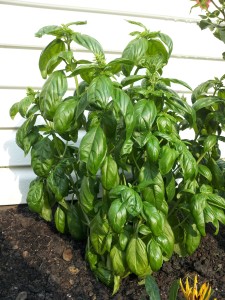When I was a child, I would frequently visit my grandmother (Yiayia) and grandfather (Papou) who lived in a small town east of Pittsburgh, Pennsylvania. They had a large yard with a view of the Monongahela River. The climate created the perfect conditions to grow a beautiful garden every summer.
My papou grew tomatoes, peppers, lettuce, and cucumbers, from what I remember. He also planted a few large basil plants, or “Vasiliko” (Greek), every year. My yiayia loved basil. She would frequently pick a stem and smell it, over and over, sometimes finally placing it to rest behind her earlobe. I imagine she found the scent comforting, as if it reminded her of her homeland in Chios, Greece. I have strong memories of my yiayia and her love of basil.
 For the past several years, I have planted a small basil plant at the start of summer. I place it near my house so I can tend to it easily. If it does not rain on a given day, I give it a good drink of water. I trim the stems to help it grow large. My husband is a beekeeper, and his bees are attracted to the white flowers that bloom at the top of the stems. This summer, I gave both my daughter and son their own basil plant to grow. It feels like an act of faith for me to tend to my basil.
For the past several years, I have planted a small basil plant at the start of summer. I place it near my house so I can tend to it easily. If it does not rain on a given day, I give it a good drink of water. I trim the stems to help it grow large. My husband is a beekeeper, and his bees are attracted to the white flowers that bloom at the top of the stems. This summer, I gave both my daughter and son their own basil plant to grow. It feels like an act of faith for me to tend to my basil.
When September 14 draws near, I say a prayer and remove many stems from my basil plant. I place them in a container filled with water and transport it to my church. Presbytera places the stems around the icons, or Father gives basil to the parishioners at the end of service.
I was curious to find out what was the true significance of basil in this holiday of September 14. I researched and found that the Empress Helene discovered the Cross in 326 A.D. in the place where Jesus had been crucified. At that same place was the flowering basil plant, which she named “Vasiliko”, meaning “of the King.” This is what ties basil to the Elevation of the Cross, the holiday we celebrate on September 14.
The Meaning of Basil at the Elevation of the Cross
The story also goes that when the Empress Helene looked under the basil, there were two other crosses as well. Those crosses were used in the crucifixion of the two thieves on either side of Christ. The Empress needed to figure out which cross was the true Cross of Christ. In order to do this, a sick woman was brought to kiss each of the three crosses. When she kissed the True Cross, she was made well immediately.
Now when you see fresh basil, remember this story and its significance to the Elevation of the Cross. This has given even more meaning to my task of planting and nurturing my yearly basil. Thank you, Yiayia, for demonstrating to me at an early age your love for this beautiful and blessed plant.

0 Comments